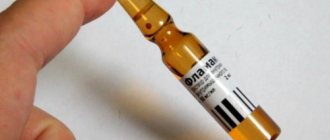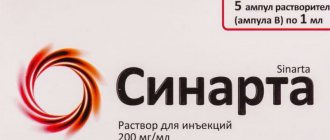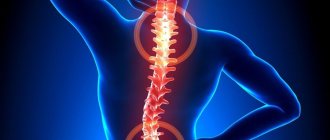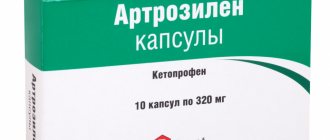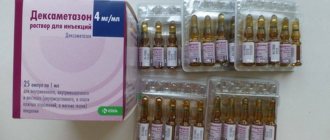Pharmacological properties of the drug Dona
Pharmacodynamics . A drug that affects metabolic processes in cartilage tissue. Glucosamine sulfate is a salt of the natural aminomonosaccharide glucosamine with low molecular weight, carefully purified from macromolecular components. The drug replenishes the endogenous deficiency of glucosamine, stimulates the synthesis of proteoglycans and hyaluronic acid in synovial fluid. Increases the permeability of the joint capsule, restores enzymatic processes in the cells of the synovial membrane and articular cartilage. The anti-inflammatory effect of glucosamine sulfate is due to blocking the formation of superoxide radicals by macrophages and inhibition of lysosomal enzymes, interleukin 1, collagenase, phospholipase A2, which leads to a slowdown in structural damage to articular cartilage, which has been repeatedly proven in long-term clinical studies. The drug promotes the fixation of sulfur in the process of chondroitinsulfuric acid synthesis and normal calcium deposition in bone tissue. Inhibits the development of degenerative processes, reduces the severity of joint pain and restores their function. Sulfates are also involved in the synthesis of glycosaminoglycans and the metabolism of cartilage tissue. The sulfate ester side chains of proteoglycans play an important role in maintaining the elasticity and water retention capacity of the cartilage matrix. A decrease in the severity of clinical symptoms is usually noted 2 weeks after the start of treatment, with clinical improvement continuing for 8 weeks after discontinuation of the drug. The results of clinical studies of continuous therapy with the drug for 3 years indicate a progressive increase in its effectiveness, expressed in regression of disease symptoms and slowdown of structural damage to articular cartilage, confirmed by X-ray. Glucosamine sulfate is well tolerated, with no significant effects on the cardiovascular, respiratory or central nervous system. Lidocaine hydrochloride is a local anesthetic that is used to reduce pain when the drug is administered intramuscularly. Pharmacokinetics . Glucosamine sulfate is quickly and completely absorbed in the small intestine (90%). Easily passes through biological barriers and penetrates tissue, mainly articular cartilage. Bioavailability - 26%. The half-life of the drug is 68 hours.
Analogs
The group of chondroprotective drugs used for intramuscular administration includes Alflutop, Adgelon, Elbona, Chondrolone, Noltrex.
It is worth noting that chondroprotectors can be used as substitutes for intra-articular fluid in case of its shortage. They not only protect cartilage from damage and destruction, but also replace synovium. Such drugs include products that contain Hyaluronic acid - Sinvisc, Ostenil, Sinokorm, Fermathron.
The use of intra-articular injections with Hyaluronic acid practically does not cause complications or side effects, since hyaluron is a natural component for the body.
They are injected directly into the articular cavity of large joints and are most often prescribed for deforming arthrosis of the knee joint. The therapeutic course consists of no more than 5 injections, but often one is enough. If necessary, the course is repeated no earlier than after 6 months.
Intra-articular injections are performed strictly in a hospital setting, since they are a surgical procedure. Injections into the hip joints (HJ) are done only in exceptional cases due to their deep location: it is extremely difficult to insert a needle into the HJ “blindly”, so the procedure is carried out under X-ray control.
Use of the drug Dona
Orally, for adults and elderly patients, 1 sachet (1.5 g) 1 time per day for 4–12 weeks or longer (if necessary). Before use, the contents of the sachet are dissolved in 200 ml of water and taken with meals. The course of treatment can be repeated 2-3 times a year with an interval of 2 months, as well as in case of relapse of the disease. The solution is intended for intramuscular administration only! Before use, mix the solvent (solution B) with the drug (solution A) in one syringe. The prepared solution is administered to adults intramuscularly, 3 ml 3 times a week for 4–6 weeks. Injections can be combined with oral administration of the drug.
Drug interactions
According to Don's instructions, it can be used simultaneously with non-steroidal anti-inflammatory drugs, glucocorticosteroids and paracetamol. The drug reduces the absorption of chloramphenicol and semisynthetic penicillins, increases the absorption of tetracyclines, and also enhances the effect of coumarin anticoagulants.
Caution must be exercised when prescribing Dona injections simultaneously with digitoxin, beta-blockers, amnodarone, ajmaline, verapamil, procainamide, quinidine, thiopental or sodium hexenal, monoamine oxidase inhibitors, cimetidine, polymyxin-B, sedatives or hypnotics
Special instructions for the use of Dona
Glucosamine, which is part of the drug, is obtained from shellfish shells, so if you are allergic to shellfish, the drug should be used with caution. The drug in powder form for oral use contains sorbitol, so it is not used for fructose intolerance. Patients on a sodium-restricted diet should be aware that the oral dosage form contains sodium (151 mg per 1.5 g daily dose). In case of diabetes mellitus, it is advisable to control glycemia at the beginning of therapy. In case of severe renal and liver failure, the drug is prescribed under the supervision of a physician. Adequate studies of the safety and effectiveness of the drug in children under 12 years of age, as well as during pregnancy and lactation, have not been conducted. The drug does not affect the ability to drive vehicles or operate machinery .
Top 10 drugs incompatible with alcohol
Why paracetamol, ibuprofen and antigrippin require an exclusively sober lifestyle
It has long been known that alcoholic beverages are not friendly with many medications. But information about which drugs should not be combined with alcohol “in the same glass” is often contradictory and confusing. As part of self-education and preparation for the “generous” Russian holidays - New Year and Christmas - we will fill the gaps in knowledge and determine the list of the most common medications that require an exclusively sober lifestyle.
Let’s say right away that “combining” does not mean washing down the drug with a glass of champagne or wine. The half-life of drugs can reach 10–12 hours, so when you take the medicine in the morning and “on the chest” in the evening, you also combine it with alcohol.
Paracetamol
Few people know that one of the most popular antipyretic and painkillers can be dangerous if combined with alcoholic beverages. In the presence of alcohol, paracetamol is metabolized in the body to form toxic substances that can cause liver damage. The danger is greatest if you combine long-term alcohol intake (for example, 90 ml of vodka or more per day for several days) with high doses of paracetamol (3000 mg or more).
Antiallergic and anti-cold medications
Alcohol consumed on the same day with some antihistamines, including the popular cetirizine and loratadine, increases the effects of the drugs on the central nervous system. This is manifested by increased drowsiness, lethargy and decreased motor activity. It should be borne in mind that many combined anti-cold medications include antiallergic components and, by the way, paracetamol.
Read also: Antibiotics and alcohol: consequences
Be sure to give up alcohol if you are taking Antigrippin (paracetamol + chlorphenamine + ascorbic acid), AntiFlu or Coldact Flu Plus (paracetamol + phenylephrine + chlorphenamine).
Nonsteroidal anti-inflammatory drugs
They are popular and sometimes almost irreplaceable. Ibuprofen, ketoprofen, naproxen, diclofenac and other NSAIDs are taken for toothaches, headaches, severe arthritis or muscle inflammation. And often consumers do not suspect that alcohol taken during treatment with NSAIDs greatly increases the risk of gastrointestinal bleeding. Let me remind you that drugs in this group are already not very friendly to the digestive tract and can cause gastropathy - stomach diseases. Alcohol can turn NSAIDs into aggressive substances that threaten real disaster.
Antitussives
Treatment with widely used medications for dry cough, including dextromethorphan, which is part of complex antitussives (Terasil-D), as well as drugs with codeine (Terpinkod) in combination with alcohol can lead to drowsiness, dizziness and weakness.
Antibiotics
Contrary to popular belief, not all antibacterial drugs are categorically incompatible with alcohol, but only some of them, in particular:
- Cefamandole
- Cefoperazone
- Chloramphenicol (chloramphenicol)
- Metronidazole
- Ornidazole
- Isoniazid (anti-tuberculosis drug)
- Sulfomethoxazole (Biseptol) and some other, rarer drugs.
When these antibiotics are used in combination with alcohol, the enzyme responsible for the decomposition of toxic acetaldehyde is blocked. The latter, when accumulated, causes difficulty breathing, tachycardia, feelings of fear, chills or fever, a drop in blood pressure, and vomiting. By the way, this is exactly how drugs that are used for “coding” against alcoholism work, in particular, disulfiram (Teturam).
Drugs for the treatment of type 2 diabetes mellitus
Diabetics generally need to be extremely careful with alcohol, as it increases blood sugar levels. Moreover, if you lean heavily on alcohol while taking glucose-lowering medications, in particular metformin (the “gold standard” for the treatment of diabetes): the risk of an extremely dangerous complication – lactic acidosis – sharply increases. It is characterized by increased levels of lactic acid in the blood, which is fatal in almost 50% of cases.
Medicines that lower blood pressure
Hypertensive patients who try to control their blood pressure with the help of medications and at the same time do not deny themselves a glass or two also risk falling victim to the incompatibility of drugs with alcohol. Doctors do not recommend combining quinapril, verapamil, doxazosin, prazosin, clonidine (Clonidine), losartan, amlodipine, lisinopril, enalapril and hydrochlorothiazide with alcoholic beverages. Otherwise, dizziness, drowsiness, fainting, and cardiac dysfunction, including arrhythmia, may occur.
Medicines that lower blood cholesterol levels
Drugs intended to normalize the content of lipoproteins (cholesterol) in the blood should also not be combined with alcoholic beverages to avoid liver damage. You should avoid drinking alcohol if you are taking statins - first-line drugs to combat dyslipidemia, namely atorvastatin, lovastatin, rosuvastatin, simvastatin.
Antidepressants
Patients with depression who are receiving drug treatment should approach alcoholic libations with extreme caution. Tricyclic antidepressants (for example, amitriptyline) in combination with alcohol produce a powerful sedative effect. The combination of small doses of alcohol with modern serotonin reuptake inhibitors (for example, paroxetine, fluoxetine, escitalopram, etc.) can still pass with impunity for the drinker. However, regular alcohol loads against the background of antidepressant therapy threaten to worsen the condition: increased anxiety and feelings of hopelessness, decreased motor functions.
Sedatives
Alcohol has a sedative, i.e., calming effect. If you take sedatives and at the same time allow yourself to “take it on your chest,” rest assured: the effect of sedatives under the influence of doses of ethanol will certainly increase, which will manifest itself as lethargy, decreased motor activity, drowsiness and loss of concentration. Therefore, it is categorically not recommended to indulge in the green snake for those who are treated with sleeping pills (zolpidem, zopiclone, doxylamine), sedatives (including herbal ones, for example, the same valerian extract), and especially tranquilizers (phenazepam, diazepam, etc.). ).
Top 10 drugs incompatible with alcohol
Why paracetamol, ibuprofen and antigrippin require an exclusively sober lifestyle
It has long been known that alcoholic beverages are not friendly with many medications. But information about which drugs should not be combined with alcohol “in the same glass” is often contradictory and confusing. As part of self-education and preparation for the “generous” Russian holidays - New Year and Christmas - we will fill the gaps in knowledge and determine the list of the most common medications that require an exclusively sober lifestyle.
Let’s say right away that “combining” does not mean washing down the drug with a glass of champagne or wine. The half-life of drugs can reach 10–12 hours, so when you take the medicine in the morning and “on the chest” in the evening, you also combine it with alcohol.
Paracetamol
Few people know that one of the most popular antipyretic and painkillers can be dangerous if combined with alcoholic beverages. In the presence of alcohol, paracetamol is metabolized in the body to form toxic substances that can cause liver damage. The danger is greatest if you combine long-term alcohol intake (for example, 90 ml of vodka or more per day for several days) with high doses of paracetamol (3000 mg or more).
Antiallergic and anti-cold medications
Alcohol consumed on the same day with some antihistamines, including the popular cetirizine and loratadine, increases the effects of the drugs on the central nervous system. This is manifested by increased drowsiness, lethargy and decreased motor activity. It should be borne in mind that many combined anti-cold medications include antiallergic components and, by the way, paracetamol.
Read also: Antibiotics and alcohol: consequences
Be sure to give up alcohol if you are taking Antigrippin (paracetamol + chlorphenamine + ascorbic acid), AntiFlu or Coldact Flu Plus (paracetamol + phenylephrine + chlorphenamine).
Nonsteroidal anti-inflammatory drugs
They are popular and sometimes almost irreplaceable. Ibuprofen, ketoprofen, naproxen, diclofenac and other NSAIDs are taken for toothaches, headaches, severe arthritis or muscle inflammation. And often consumers do not suspect that alcohol taken during treatment with NSAIDs greatly increases the risk of gastrointestinal bleeding. Let me remind you that drugs in this group are already not very friendly to the digestive tract and can cause gastropathy - stomach diseases. Alcohol can turn NSAIDs into aggressive substances that threaten real disaster.
Antitussives
Treatment with widely used medications for dry cough, including dextromethorphan, which is part of complex antitussives (Terasil-D), as well as drugs with codeine (Terpinkod) in combination with alcohol can lead to drowsiness, dizziness and weakness.
Antibiotics
Contrary to popular belief, not all antibacterial drugs are categorically incompatible with alcohol, but only some of them, in particular:
- Cefamandole
- Cefoperazone
- Chloramphenicol (chloramphenicol)
- Metronidazole
- Ornidazole
- Isoniazid (anti-tuberculosis drug)
- Sulfomethoxazole (Biseptol) and some other, rarer drugs.
When these antibiotics are used in combination with alcohol, the enzyme responsible for the decomposition of toxic acetaldehyde is blocked. The latter, when accumulated, causes difficulty breathing, tachycardia, feelings of fear, chills or fever, a drop in blood pressure, and vomiting. By the way, this is exactly how drugs that are used for “coding” against alcoholism work, in particular, disulfiram (Teturam).
Drugs for the treatment of type 2 diabetes mellitus
Diabetics generally need to be extremely careful with alcohol, as it increases blood sugar levels. Moreover, if you lean heavily on alcohol while taking glucose-lowering medications, in particular metformin (the “gold standard” for the treatment of diabetes): the risk of an extremely dangerous complication – lactic acidosis – sharply increases. It is characterized by increased levels of lactic acid in the blood, which is fatal in almost 50% of cases.
Medicines that lower blood pressure
Hypertensive patients who try to control their blood pressure with the help of medications and at the same time do not deny themselves a glass or two also risk falling victim to the incompatibility of drugs with alcohol. Doctors do not recommend combining quinapril, verapamil, doxazosin, prazosin, clonidine (Clonidine), losartan, amlodipine, lisinopril, enalapril and hydrochlorothiazide with alcoholic beverages. Otherwise, dizziness, drowsiness, fainting, and cardiac dysfunction, including arrhythmia, may occur.
Medicines that lower blood cholesterol levels
Drugs intended to normalize the content of lipoproteins (cholesterol) in the blood should also not be combined with alcoholic beverages to avoid liver damage. You should avoid drinking alcohol if you are taking statins - first-line drugs to combat dyslipidemia, namely atorvastatin, lovastatin, rosuvastatin, simvastatin.
Antidepressants
Patients with depression who are receiving drug treatment should approach alcoholic libations with extreme caution. Tricyclic antidepressants (for example, amitriptyline) in combination with alcohol produce a powerful sedative effect. The combination of small doses of alcohol with modern serotonin reuptake inhibitors (for example, paroxetine, fluoxetine, escitalopram, etc.) can still pass with impunity for the drinker. However, regular alcohol loads against the background of antidepressant therapy threaten to worsen the condition: increased anxiety and feelings of hopelessness, decreased motor functions.
Sedatives
Alcohol has a sedative, i.e., calming effect. If you take sedatives and at the same time allow yourself to “take it on your chest,” rest assured: the effect of sedatives under the influence of doses of ethanol will certainly increase, which will manifest itself as lethargy, decreased motor activity, drowsiness and loss of concentration. Therefore, it is categorically not recommended to indulge in the green snake for those who are treated with sleeping pills (zolpidem, zopiclone, doxylamine), sedatives (including herbal ones, for example, the same valerian extract), and especially tranquilizers (phenazepam, diazepam, etc.). ).
